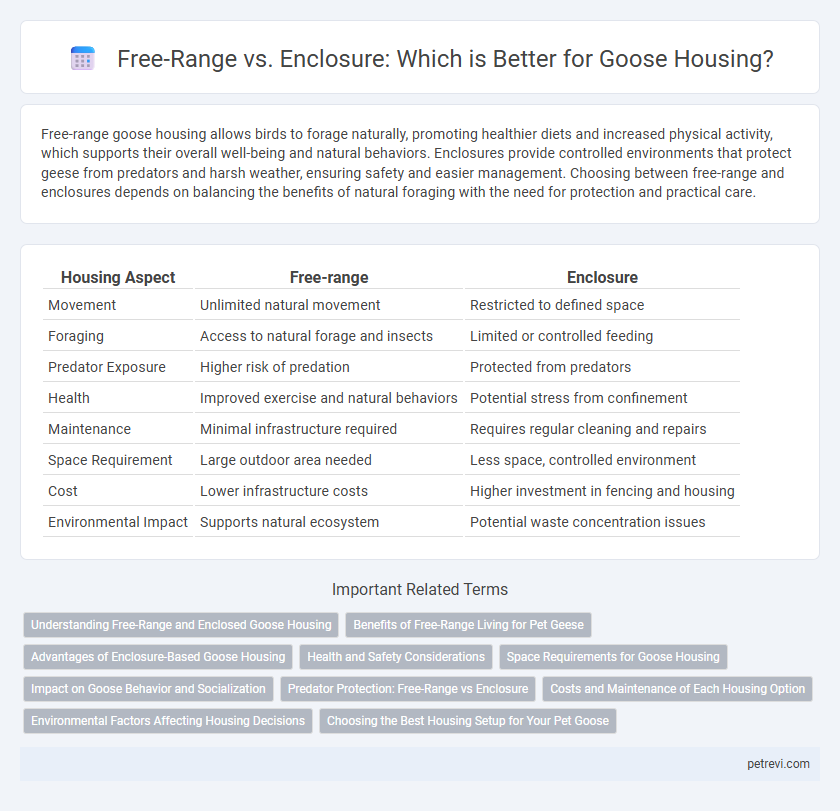Free-range goose housing allows birds to forage naturally, promoting healthier diets and increased physical activity, which supports their overall well-being and natural behaviors. Enclosures provide controlled environments that protect geese from predators and harsh weather, ensuring safety and easier management. Choosing between free-range and enclosures depends on balancing the benefits of natural foraging with the need for protection and practical care.
Table of Comparison
| Housing Aspect | Free-range | Enclosure |
|---|---|---|
| Movement | Unlimited natural movement | Restricted to defined space |
| Foraging | Access to natural forage and insects | Limited or controlled feeding |
| Predator Exposure | Higher risk of predation | Protected from predators |
| Health | Improved exercise and natural behaviors | Potential stress from confinement |
| Maintenance | Minimal infrastructure required | Requires regular cleaning and repairs |
| Space Requirement | Large outdoor area needed | Less space, controlled environment |
| Cost | Lower infrastructure costs | Higher investment in fencing and housing |
| Environmental Impact | Supports natural ecosystem | Potential waste concentration issues |
Understanding Free-Range and Enclosed Goose Housing
Free-range goose housing allows geese to roam freely in natural environments, promoting natural behaviors and better health through access to fresh foraging and sunlight. Enclosed housing confines geese to controlled spaces, offering protection from predators and harsh weather but limiting movement and natural grazing opportunities. Understanding the benefits and limitations of both systems is essential for optimizing goose welfare and productivity based on specific farming goals.
Benefits of Free-Range Living for Pet Geese
Free-range living allows pet geese to exhibit natural behaviors such as foraging, swimming, and social interaction, which enhances their physical health and mental well-being. Access to diverse vegetation and open spaces increases nutrient intake and reduces stress-related illnesses compared to enclosure housing. Exposure to varied environments also promotes stronger immunity and overall longevity in free-range geese.
Advantages of Enclosure-Based Goose Housing
Enclosure-based goose housing offers enhanced protection from predators and adverse weather conditions, ensuring higher survival rates and better health management. Controlled environments in enclosures facilitate easier monitoring of nutrition, breeding cycles, and disease prevention, contributing to improved productivity. Enclosures also minimize land use and environmental impact by containing waste and reducing habitat destruction compared to free-range systems.
Health and Safety Considerations
Free-range goose housing promotes natural foraging behaviors and reduces stress, enhancing overall health and immune function by providing a varied diet and ample space to move. Enclosure systems offer protection from predators and environmental hazards, minimizing injury risks and disease exposure through controlled sanitation and monitoring. Balancing open access with secure shelter is crucial for optimal health outcomes and safety in goose management.
Space Requirements for Goose Housing
Free-range goose housing requires ample open space, typically a minimum of 25 to 30 square feet per bird, to support natural foraging, social behaviors, and exercise. In contrast, enclosure housing demands carefully calculated space allocations of around 10 to 15 square feet per goose to prevent overcrowding and stress-related issues. Proper spatial planning in both systems directly influences goose health, growth rates, and overall welfare.
Impact on Goose Behavior and Socialization
Free-range housing allows geese to express natural behaviors such as foraging, swimming, and grazing, promoting healthier physical activity and mental stimulation. Enclosure-based housing restricts movement, often leading to increased stress, aggression, and abnormal behaviors due to limited social interaction and space. Studies indicate that free-range environments enhance social bonding and reduce dominance-related conflicts among geese, contributing to improved welfare and productivity.
Predator Protection: Free-Range vs Enclosure
Enclosures provide superior predator protection for geese by limiting access through secure fencing and controlled entry points. Free-range systems expose geese to higher risks from natural predators such as foxes, raccoons, and birds of prey due to the absence of physical barriers. Implementing secure enclosures significantly reduces predation incidents and enhances overall flock safety.
Costs and Maintenance of Each Housing Option
Free-range goose housing typically involves lower initial construction costs but requires more extensive land management and ongoing maintenance to prevent overgrazing and predator threats. Enclosure housing incurs higher upfront expenses due to fencing, shelter construction, and security measures but allows for easier disease control and concentrated feeding, reducing daily labor. Cost-effectiveness depends on farm size, predator prevalence, and maintenance capacity, with free-range favoring low-budget extensive farming and enclosures suiting intensive, manageable environments.
Environmental Factors Affecting Housing Decisions
Environmental factors such as climate, available land, and predator presence critically influence the choice between free-range and enclosure housing for geese. Free-range systems require ample space with natural vegetation and water access, promoting natural behaviors but increasing exposure to weather extremes and predators. Enclosures offer controlled conditions that mitigate these risks but may limit natural foraging opportunities and require enhanced ventilation to manage humidity and temperature.
Choosing the Best Housing Setup for Your Pet Goose
Free-range housing allows geese to forage naturally, promoting healthier instincts and enhanced physical activity while offering space for social behaviors. Enclosure setups provide controlled environments that protect pet geese from predators and harsh weather, ensuring safety and ease of management. Selecting the best housing depends on balancing freedom of movement with protection, considering factors like space availability, local climate, and potential threats.
Free-range vs Enclosure for Goose housing Infographic

 petrevi.com
petrevi.com